Newspapers
March 16, 2012 Chunichi Shimbun
August 30, 2011 Asahi Shimbun Article

Translation 1
courtesy of symbv from evageeks forum (an alternate translation is available)
Prophecy from the Past No.5 of 5
Someone's Justice is Someone's Evil
Asahi: Madoka Magica is an original story. Where did the idea come from?
Urobuchi: I received a request to write a sanguinary story where mahou shoujo appear and then drop out one by one. I turned my attention to the aspects in conventional “mahou shoujo anime” that do not look right or are overlooked. I thought that when [someone] acquired superhuman power and thus became an existence that was removed from the world, contradictions and trade-offs would be generated.
Asahi: Mahou Shoujo who were full of hope working to save people became tormented with hatred and jealousy before long, and they turned into the witches, their enemies. The change from good to evil made a strong impression.
Urobuchi: For example, Al-Qaeda brought down the Twin Towers in order to fulfill their own sense of justice. Justice for some people is evil for some. Good intentions, kindness, and hope will not necessarily make people happy.
Asahi: At the climax of the anime, a bunch of witches merged and brought catastrophe onto the city. And even in real life society, could the negative emotions of humans be the precise thing that could destroy this world?
Urobuchi: Perhaps we can say “a curse calls for another curse” – Hatreds form a chain. And I think that is the most terrifying. One can talk about positive words like happiness, victory, glory only after he dumped anything that stands in contrast to them to the trash bin. But even when stenches emerged from there and it got infested with maggots, he still pretended he did not see that and attempted to illuminate the whole world in bright lights. Countries such as America push this kind of negative management towards the third world while showing themselves as being prosperous.
Asahi: Facing the catastrophe, one of the characters in the cast kept starting over time in an attempt to prevent it. Her action is so tragically heroic. This kind of “time loop genre” technique has become a prominent way of expression in the 2000s.
Urobuchi: I think that is a convenient way to express the feeling of entrapment. The “King of Terror” [TN: a Nostradamus reference] of 1999 did not end the world. During the 80s and 90s, there was the impatience and festival mood regarding a possible end of the world and people were able to share an apocalyptic image like nuclear war.
Asahi: But the world kept going.
Urobuchi: Although the end did not come, the situation does not necessarily turn for the better. The mood is now one where the days in which some sort of troubles keep tormenting [people] seem to be going to last forever.
Asahi: So there is no absolute justice nor absolute termination. In the anime, there is a scene in which one of the mahou shoujo, who was being philosophical, said “if we pray for hope, there will be a same amount of despair scattered around. The balance in the world is obtained by both canceling each other out.”
Urobuchi: If one chases after hope, despair will always follow. And one must take this as the precondition. Just like you must solidify the oil and throw it away when you make tempura, there is no way you can produce only nice things without producing any waste.
Asahi: Nuclear power was supposedly established with the wish for life of abundance but now we have nuclear radiation being scattered around. It brings to mind the aphorism “Hope that is not in keeping with reason brings about distortion” from the dialogues.
Urobuchi: Now that it is power conservation, power conservation, but it would have been better if some thoughts had gone to [creating] a world that does not need to have dangerous things made. Do we want the shiny Christmas illumination after full consideration of the risk of radioactive contamination?
Asahi: But then people cannot live without hoping for something....
Urobuchi: Let me go back to the topic of Al-Qaeda. There is no doubt that they have the thought of wanting to righteously guide the world. Madoka, the protagonist, made a certain decision at the end, and that was because she did not want to negate what the many mahou shoujo had wished for themselves.
Translation 2
Translation from ANN and Cytrus
Asahi: Madoka Magica is an original story. Where did the idea come from?
Urobuchi: I received a request to write a bloody story where magical girls appear, and then drop out one by one. I paid attention to the aspects that are troubling or overlooked in the traditional magical girl genre. I’ve been thinking that magical girls who have acquired superhuman abilities will find themselves removed from the world, which would cause contradictions and reactions.
Asahi: Magical girls, who are full of hope and who strive to save the people, soon suffer from hatred and jealousy, which turn them into the enemy witches. The change from good to evil left an emotional impact.
Urobuchi: For example, Al-Qaeda brought down the Twin Towers due to their self-righteousness. Justice for some people is an evil for others. Good intentions, kindness, and hope will not necessarily make people happy.
Asahi: In the climax of the series, witches bring a disaster upon the city. Isn’t it that in modern society, people’s negative emotions are what destroys the world?
Urobuchi: One curse brings about another, creating a cycle of hatred. That’s what I find the most terrifying. Positive words like happiness, victory and glory are only spoken after being thrown into the same trash can with their opposites. Even if it starts smelling or maggots get out, we pretend not to notice and paint the world in bright colors. America, for example, could be seen as having gained and maintained its prosperity by forcing its own negatives on Third World countries.
Asahi: In the face of the disaster, one of the characters repeats the same time period in a loop several times. Her struggle to stop the event fills the viewer with pity. The usage of such loop has become a common form of expression since the last decade.
Urobuchi: I think it’s a useful way of conveying the feeling of entrapment. The panic of 1999 didn’t bring the end of the world. In the 80′s and 90′s there was a lot of shouting and worrying that the end might come, and many images of the apocalypse, like the nuclear war fallout, were created in the public mind.
Asahi: The end didn’t come, but it’s not like the situation has improved. Is seems those troubled days will never end.
Urobuchi: There is no absolute justice and no absolute conclusion. In the anime series, there is a scene where one magical girl argues that “By trusting in hope, you only bring about equally strong despair. The world is made to keep its final balance at zero.” Even if we chase after hope, despair is sure to follow. We must be willing to accept this from the beginning. To make some tempura, we have to throw out the oil used. It is impossible to create something beautiful without producing waste matter in the process.
Asahi: The nuclear reactors which were supposed to bring us abundant life now spread radioactive material. “Desires which go against logic bring about distortions”, this anime line sounds life a fitting aphorism for this situation.
Urobuchi: Now everyone goes on and on about saving electricity, but we should have thought about a world which doesn’t require such dangerous things to be built in the first place. I thought we were aware of the risk of radioactive pollution when we wished for the brilliant Christmas illuminations.
Asahi: But isn’t it that humans cannot live without desiring something?
Urobuchi: Getting back to Al-Qaeda, the desire to lead the world in the right direction is not wrong in itself. The decision Madoka, the main character, makes at the end of the series is the result of her not wanting to deny the fact that the magical girls held hope.
March 2, 2011 Yomiuri Shimbun Article
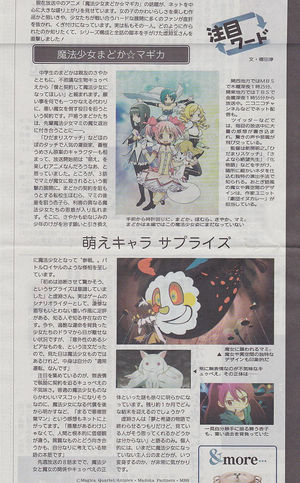
Source: Yomiuri Shimbun, Mar. 4, 2011. [1]
THROUGH OTAKU EYES / There's something magical about 'Madoka'
Makoto Fukuda / Yomiuri Shimbun Staff Writer
One of the latest anime series to cause a stir on both TV and the Internet is the new Puella Magi Madoka Magica. At first glance, it appears to be just any old anime populated with young, pretty girls. Yet it is the unforgiving storyline in which girls fight each other that has left many fans astonished and hooked. I'm no different: I wait each week for the next installment with baited breath.
As soon as I realized the appeal of this series, I immediately set out to interview Gen Urobuchi, the man responsible for its scripts and story arc.
The show starts the way any other so-called magic girl story would begin: A middle-school girl named Madoka and her friend Sayaka are approached by a strange creature named Kyube, who offers them magic powers, which they must use to battle evil witches.
In exchange, each new magic girl will receive a single wish. Bewildered by the prospects, the two girls decided to accompany an experienced magic girl named Mami on a witch hunt.
After learning that the characters were designed by popular mangaka Ume Aoki (Hidamari Sketch), I immediately jumped to the conclusion the show would be pure moe--fetishistic cuteness. But in Episode 3, however, the story took a shocking turn when Mami was slain by a witch.
At this point, a number of other magic girls enter the picture, including Homura, a transfer student who tries to stop Madoka from making her witch deal, and Kyoko, who tries to take Mami's place. Sayaka decides to join the battle to obtain a wish to heal her childhood friend, with whom she has fallen in love.
"I wanted to catch viewers off guard and then reward them," Urobuchi said.
As a game scenario writer, Urobuchi is noted for heavy, often gruesome, storylines and a devoted following. I have been unable to tear myself away from this story of young girls facing hardship. Urobuchi said he was tasked with creating a serious anime that contained an element of surprise. He decided to apply his usual style to the often cliche magic girl genre.
Proving popular with anime fans is the eerie Kyube and the expressionless countenance the character has when pressing these girls into service. In any other series from this genre, Kyube likely would have been the show's mascot. Many fans on the Internet see the mysterious character as an evil salesperson who reveals the price of wish fulfillment only after these girls agree to become magic girls.
These same fans, however, are convinced Kyube does not mean to harm anyone, but merely has a fundamentally different set of values than humans. They see Kyube as an embodiment of the manga, which has its own approach to dealing with things that are alien.
The anime is directed by Akiyuki Shinbo, whose works include Hidamari Sketch, So long, Mr. Despair and Bakemonogatari. He is known for his distinctive direction, characterized by the inclusion of small surprises throughout his work. The witch and space design is by the Gekidan Inu Curry art duo.
By Episode 8, mysteries had begun to unveil, including those about the relationships between the magic girls and the witches, as well as Kyube's true identity. The series is scheduled to end in about a month, and I am very curious about how it will conclude. Personally, I'm anxiously awaiting Madoka's transformation into a magic girl.
Urobuchi would not say any more about where the series was headed, except that it is a story about dreams and hopes. He added, however, "I'm not sure if the viewers will agree with me about that."
Fukuda is a Yomiuri Shimbun staff writer specializing in anime and manga.
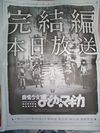
April 20, 2011 Yomiuri Shimbun Ad
Ad placed shortly before episode 11 and 12 aired.
Aniplex placed a full page ad in Yomiuri Shimbun (largest newspaper circulation in the world) which 2ch sources estimated an expenditure of 49,455,000 yen (approximately 600K USD).
There were reports that Yomiuri Shimbun sold out in many places because of this ad.
May 2011 Asahi Evening Newspaper
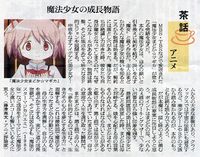
From Asahi Evening (朝日夕刊) newspaper, early May 2011.
Summary from symbv from evageeks.forum:
Besides the introduction of what PMMM is about, the author (who was billed as an anime critic) presented the following insights:
- PMMM saw quite a lot of influence from gal game and he believes an "orthodox" interpretation of the anime should be taken from the perspectives of gal game and sci-fi.
- One important ingredient of enjoying the anime, in his view, is the undercurrent of the character development of the protagonist Madoka. And he believes the key to it is Madoka's mother who left a strong impression even though she made only infrequent appearances.
- He compared the Madoka in Ep.11 when she would reply to a worrying mother's words with a determination about thing that she had to do and wanted to do, and the Madoka in Ep.1 when she would meekly (but happily) accepted her mother's advice of wearing a ribbon to school.
- He then picked up Madoka's mother words in Ep.3 "living life not to make your dream the goal but to turn this way of living life into your dream", and commented that this was clearly understood by Madoka then. This led to the actions she managed to do in Ep.12.
- He believes PMMM could be viewed as an orthodox coming-of-age story. Here Madoka got to understand how her beloved mother lived her life and at the end through this Madoka made the decision of how she wanted to live her life.
- He also saw similarity of PMMM to the 1985 mahou shoujo anime "Magical Emi, the Magic Star" in its theme of dealing with growing up.
Another translation summary: Seems to be a column deciphering some story-points. It talks about the girls contracting and then being forced to fight witches and the hidden magical girls equals witches rule. With this as the focal point in the last part of the story it gets its sci-fi twist. There is also something about galges being an influence. It also talks about the character growth. Madoka's mum leaving a strong impression as a working mother and with her rough speech, coming into confrontation with Madoka in ep 11. It relates to episode 1 where her mom choose the ribbons for her, but now she chooses her path for herself. That's also in relation to the episode 3 talk about her mom's lifestyle choice/dream and how she gets satisfaction out of that. There is also a mention of magic star magical emi having a similar theme.
November 2013 Asahi Newspaper
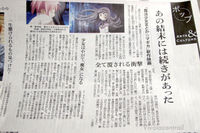
Asahi Shinbum is the 2nd largest newspaper in the world (and Japan) by circulation.
September 29, 2015 Sankei Shimbun
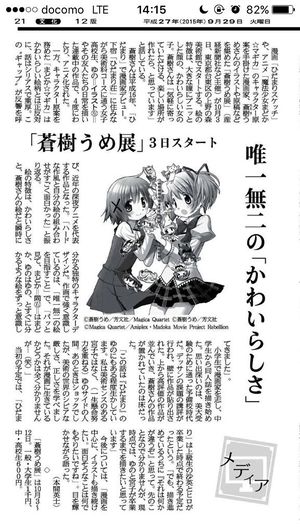
Sankei Shimbun is considered one of the five "national" newspapers in Japan. Translated by Anonymous:
Aoki Ume Exhibition starts 3rd of October (sponsored by Sankei Shimbun et al.). The unique cuteness of Aoki Ume.
An exhibition featuring the illustrations, drafts, and other works of Aoki Ume, the mangaka responsible for the manga "Hidamari Sketch" and the original character designs for "Mahou Shoujo Madoka Magika" is starting October 3rd in the Ueno Royal Museum in Tokyo. The characteristic of her art is cute girls with big, round eyes and soft faces. "Our goal was to make somewhere you could visit and forget your worries", Aoki-san says.
Aoki-san's debut as a mangaka was in 2004 with "Hidamari Sketch". The story is about Yuno and her group of friends living in an apartment building called "Hidamari-sou" while attending an art program in a nearby high school. The story of the daily lives of Yuno and her friends is still being serialized, and an anime spanning four seasons has been produced.
On the other hand, Aoki Ume has also worked as the original character designer for "Madoka Magika", where her cute art was contrasted by the serious story. It's because of this gap that Madoka Magika has become the representative for late night anime in the past few years. "Combining my drawings with a darker writing style was really interesting", she says, looking back.
Even if cuteness is her main feature, her character designs are instantly recognizable thanks to a unique flair. She has made a conscious effort toward it while drawing, and she says "I have been aiming to draw something unique. Something where you can tell that Yuno is Yuno and Madoka is Madoka even if you only saw a glimpse."
In elementary school she wanted to be a mangaka, and in middle school she started to draw her own doujinshi. Her memories from the time when she was in a prep school for an art college are unforgettable. In the prep school they graded the sketches by hanging them on a wall. The best ones were lined at the top, while Aoki-san's works ended up near the floor. "I used this story in Hidamari where it happens to Yuno. I'm not naturally talented like Miyako, so I'm quite like Yuno (whose talent is build on hard work). I was really shocked back then, but I learned how hard and straightforward the world of art is. I'm not really sure if the honesty of that world really shows in my manga though." she says and laughs.
At first the plan was to end Hidamari when Yuno's upperclassmen Sae and Hiro graduated. "But when I continued drawing, I realized that something wasn't right about that. I don't know about the future, but currently the plan is to continue the manga until Yuno and Miyako graduate."
When discussing the future, Aoki-san eyes start to gleam. "I want to keep drawing, with manga being the biggest part of it all. There are so many interesting things I want to do!"
- Honma Eiji, Sankei Shimbun. September 29, 2015
Gallery
-
E Sanyou, March 2011
-
Article on Madoka Cafe, June 2011
-
Yomuiri Evening article, May/June 2011.
-
Yomiuri Newspaper Ad, June 2011. Showing advertisement with a new look for Madoka, after the series ended.
-
June 2011.
-
July 28, 2011. Nikkei discussing Madoka's popularity.










